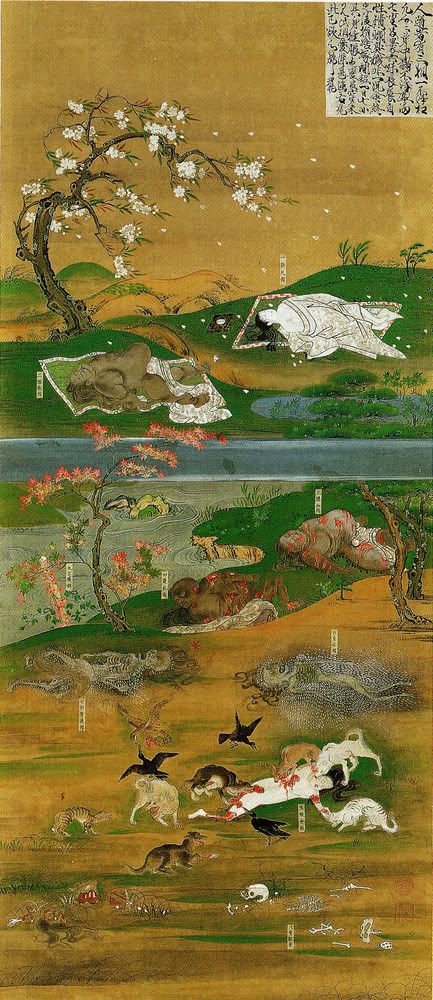In her introduction, Reider relates a trip to the oni museum in Ôe-machi, Kyoto where she acquired a booklet that features an intriguing quote in reference to the story of Shuten Dôji. (Shuten Dôji is an oni lord who systematically kidnaps beautiful young maidens from Kyoto, subjects them to his various [and unnamed] pleasures, and then devours them. In response to this menace, the court sends a group of warriors—under the command of Minamoto no Raikô (948-1021)—to deal with the matter. Raikô succeeds in killing the oni, but only through an act of subterfuge.) Reider makes the following comment about the booklet quote:
A small explanation of the [booklet's] front page picture—monstrous Shuten Dôji's head biting Minamoto no Raikô's helmet—reads, "There is nothing false in the words of demons." A friend of mine who was traveling with me saw it, and repeated the phrase, deep in thought. She was apparently sympathizing with Shuten Dôji as someone who was naively deceived.
For Reider, this interpretation of the legend of Shuten Dôji is indicative of the tendency among contemporary Japanese to view the oni as a figure of marginalization and mistreatment. However, I think that it also reveals a very interesting difference between the behavior-governing concepts of morality and ethics and the tendency of villains to subscribe to the latter rather than the former.
In my view, moral behavior comprises actions that are taken in response to the expectations of an external force. Adherence to the dictates of the biblical Ten Commandments, or the traditions of society, or the laws of government—to name but a few—fall into the category of moral behavior. They are dictates that are followed out of a sense of fear (of censure or punishment) rather than out of a deeply ingrained sense of right or wrong. By contrast, ethical behavior comprises actions that are taken in response to one's personal expectations. Adherence to a specific code of behavior that makes no reference to the dictates of religion, society, or government fall into the category of ethical behavior. They are dictates that are followed out of a sense of right and wrong and may be either more or less worthy than external dictates, and it goes without saying that they are highly subjective. (1)
While it is common for villains such as Shuten Dôji to act outside of the bounds of moral behavior—that is to say, outside the bounds of what society expects—they do tend to follow their own personal code of ethics. Shuten Dôji kidnaps, (sexually) abuses, and devours young women, but he would never stoop to an act of deceit to achieve his goals and is therefore vanquished when an otherwise noble warrior stoops to such a level to defeat him. (2) Another contemporary, and Western example, of this phenomenon, Hannibal Lecter, is perfectly at ease with stalking, abducting, torturing, and consuming other people, but he would never dream of doing so to someone like Clarice Starling—a person who has met him on his own terms and established mutual respect through the exchange of highly personal information. As Starling struggles to explain after Lecter's escape: "[Lecter] won't come after me; he would consider that rude." (3)
This disconnect between morality and ethics lies at the root of the both the villain's symbolic role as social other and his perennial popularity and inevitable romanticization. The failure to adhere to moral codes irrevocably others the villain, but their often rigid adherence to a personal and demonstrable code of ethics makes them an object of sympathy. It might be said then that the villain occupies a consistently liminal space in cultural consciousness; it is through this that the villain subverts ordinary social constructs and acts as a tool of critique—a process that I'm sure has been noticed before and that I would love to read more about.
If anyone has any suggestions for good explorations of this topic, I'd love to hear them.
Notes:
1) It is also perfectly common for the moral and the ethical to overlap; each are characterized not by the activity in question but by the underlying motivation for undertaking said activity. In the simplest terms moral behavior is defined by the opinions of others while ethical behavior is defined by one's own opinions.
2) I have often thought that heroes, in contrast to villains, are often characterized by the dilemma of having to act in one unethical manner in order to uphold a moral or ethical requirement. It is often the fate of the hero to "become what he beholds" in the course of his quest to overturn evil.
3) I imagine that everyone has seen Silence of the Lambs, but anyone who hasn't is heartily encouraged to do so. It is an unequivocal masterpiece of modern horror. DVD, directed by Jonathan Demme (MGM, 1991).
Bibliography of notable works by Noriko T. Reider (organized by date):
* Tales of the Supernatural in Early Modern Japan: Kaidan, Akinari, Ugetsu Monogatari. Japanese Studies Volume 16. Lewiston: The Edwin Mellen Press, 2002.
* "Transformation of the Oni: From the Frightening and the Diabolical to the Cute and Sexy." Asian Folklore Studies 62, no. 1 (2003): 133-157.
* "Onmyôji: Sex, Pathos, and Grotesquery in Yumemakura Baku’s Oni." Asian Folklore Studies 66, no. 1/2 (2007): 107-124.
* "Animating Objects: Tsukumogami ki and the Medieval Illustration of Shingon Truth." Japanese Journal of Religious Studies 36, no. 2 (2009): 231-257.
* Japanese Demon Lore: Oni from Ancient Times to the Present. Logan: Utah State University Press, 2010.

This work is licensed under a Creative Commons Attribution-NonCommercial-ShareAlike 3.0 Unported License.
